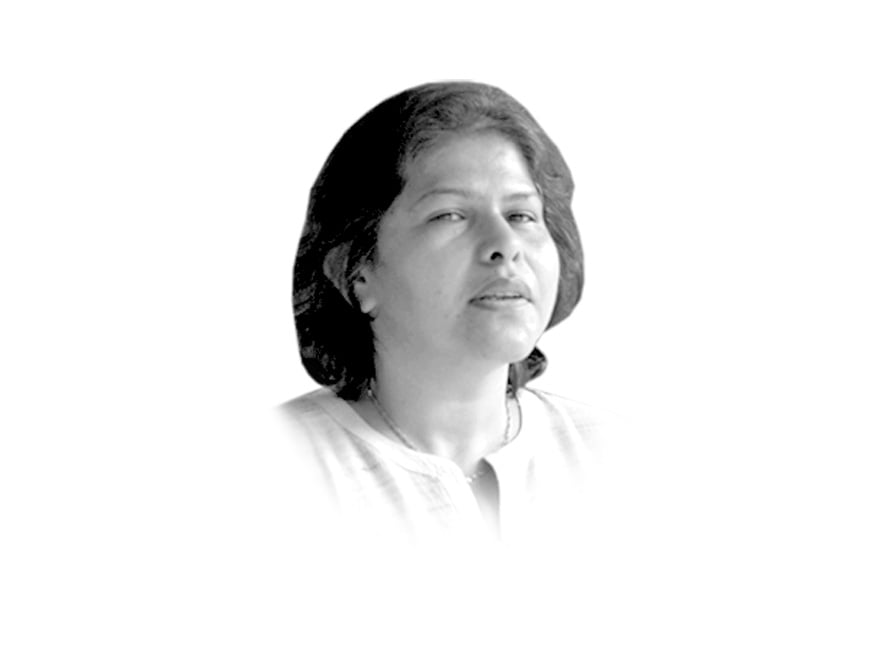

But the world of Coke Studio and the artists, writers and painters, Jalal points out, is very different from the space in which ordinary folk live. The discourse of this other world is quite different. The suicide bomber who blew 61 Shias to death in Shikarpur, Sindh, belonged in the latter space. Abida Parveen, Allan Fakir, Sheikh Ayaz and many luminaries also come from Sindh. This fact does not negate the other reality of gradual radicalisation of Sindhi society in the past couple of decades or more. There has been an emergence of a network of madrassas in Sindh funded from the Gulf or people influenced by retrogressive thinking, which they believe is religion. In fact, businessmen from Karachi finance madrassas in sectarian hotbeds in south Punjab. The slogans scribbled on the carcass of burnt Nato tankers outside Shikarpur announce victory of both the Islamic system and the PTI in Pakistan. The jihadi graffiti on walls all over Sindh is another reminder of the change. People still go to Shahbaz Qalandar’s shrine but this does not stop the emergence of radicalism in society.
The absence of a counter-narrative to feudalism, emergence of a new rural and urban middle class that desires power, and a myopic ‘pragmatism’ of Sindhi politicians has contributed tremendously to such change. Not to forget the state’s strategic objectives. The Sindh chief minister’s hometown has madrassas that market a rabid ideology and have been the source of violence in the past. Notwithstanding Bilawal Bhutto’s challenge to the Taliban or a few gestures here and there, the PPP government has watched over the change. The friends and supporters of militants lie in its ranks as they do in other parties in the province.
The emergent violence and growing radicalism cannot be brushed aside simply as being driven by personal greed and resultant extortion, which is how fiction writer Saadat Hasan Manto described the 1947 carnage. For him, religion was not the source of Partition violence. However, the massacre in Shikarpur was driven by a skewed religious perception, as is the bloodshed of Hazaras, Ahmadis and even Sunnis. Such transformation of society was inevitable from the time we silently endorsed the killings of people in 1971 in the then-East Pakistan. Ordinary Bengalis were seen as conduits of Indian conspiracy and hence the need for violence. Ever since then, school textbooks blame the dominance of Hindu teachers as the cause of Pakistan’s partition.
Can we admit that the problem is not simply one of re-imagining Pakistan, but a more fundamental one of the dominant narrative being that of a clash of civilisations? Since a country’s literature maps socio-political ethos of its people, do we realise that it is not Manto but Naseem Hijazi who played a greater role in shaping people’s imagination? Literary critic Ajmal Kamal has often written about the difference between “internationalised” literature festivals in Pakistan and those that ordinary folks go to. The two worlds are worlds apart. While the former struggles to appear hip and politically correct, the latter is comfortable with its political incorrectness. Most importantly, the two market different types of literature and cater to different audiences.
This is not something new. The world of literature was always divided between writers which the literary community thought ‘should be taken seriously’ and writers rated as ‘B-class’ ones. It is the latter that shaped public imagination and were in greater circulation. Hijazi fictionalised history that went on to shape people’s minds. The theory of the ‘clash of civilisations’ did not start with Samuel Huntington, but with Hijazi who, in novel after novel, talks about militant and powerful Muslim warriors fighting against Jews, Christians and Hindus. Other writers from this genre, like Tariq Ismail Saghar, glamourised battles against foreign threats, essentially modern inter-religious conflicts played out in the form of Pakistan versus the CIA and RAW. Ashfaq Ahmed, who was initially not in this category, joined with his post-Zia reincarnation to market subservience to authoritarianism in the name of Sufism. Similarly, Bushra Rehman, who is for women what Hijazi is for men, laid out the characteristics of an ideal Muslim woman. And while Manto was ignored and abused by the state, his contemporary Hijazi told tales of mujahids. His novel Dastan-e-Mujahid (Mujahid’s Tale), for instance, makes jihad and martyrdom look normal, something that every Muslim household must desire. In any case, parents and teachers object to the youth reading Manto, a problem they don’t have with Hijazi, whose novels are found in the libraries of every school and college. For this category of readers, the Faiz and Manto brand does not matter. This crowd will not ban what they don’t agree with but they are mindful of the barriers that separate the world of friends from foes.
The imaginary world of Hijazi and the like is constantly uncomfortable and in conflict with everyone considered as part of the ‘other’. Thus, the intellectual ground is furrowed for mullahs and militants to sow their seeds in. Violence is part of the harvest. The rest goes in constructing religious nationalism.
Published in The Express Tribune, February 5th, 2015.
Like Opinion & Editorial on Facebook, follow @ETOpEd on Twitter to receive all updates on all our daily pieces.
COMMENTS (14)
Comments are moderated and generally will be posted if they are on-topic and not abusive.
For more information, please see our Comments FAQ

1730959638-0/trump-(19)1730959638-0-165x106.webp)










@Hassan: of course he didn't, but he was of the view that Muslims should kill infidel, now Taliban declare you infidel ASWJ declare shia infidel and kill you and shia.
IF,
Muslims could not live safely and honourably as a minority in a United India.
THEN,
How is it possible for other Minorities to do so in a Muslim Pakistan?
Can some one explain this PLEASE.
@raider: I had partially addressed this in a longer comment which ET moderator(s) did not allow, even though it was rational and. as always, did not use bad or insulting language. (There seems to be an arbitrariness creeping in the screening process in what comments go through [e.g. wb] and which ones are stopped. Oh, well!).
@Yo2Da2: is religious extermism is exclusive to pakistan wholly, where do fit ISIS and AL-QUIDA
Excellent. Really excellent. But I am not agreed with Ayesha Jalal that Pakistan was not created as a religious state nor will it get radicalized. When you exploit/ use the name of religion for a state ultimately that will be radicalized sooner or later. What kind of Islamic State Mr.Jinnah wanted is a confused issue forever.
@raider Was Charlie Hebdo a Pakistani writer or cartoonist? How does that fit in with what the good doctor is talking about?
Let's not forget the role payed by the Naseem Hijazi of kids, Ishtiaq Ahmad. In th 80s and 90s, he poisoned the minds of millions of kids with hate and jingoism that even exceeded Naseem Hijazi's fantasies.
The first casualty of religion is reason.
And looks like the author's own reasoning is taking a beating.
I would urge the writer to keep it simple in the future and not confuse the people with half baked ideas of 100 different people. Remember KISS and keep your narrative simple.
Simply put, Islam - when taken literally - is an unnatural ideology. Islam has never been at peace with itself from the very beginning. I mean imagine the founder of a religion going on wars to convert people! How can such an ideology be at peace with itself?
The only way to peace in the future is to accept Islam largely as a guide and not as a complete way of life. Christians have done that. Christians have moved away from Bible and the church and finally there's peace and stability in the Christian world.
Until this happens, Islamic world, and in particular Pakistan, will continue to be violent, depraved, deprived and depressingly regressive.
I'm positive that Muslims will see this and change will come. But unfortunately, it will take another century at least and by then there will be too much Muslim blood spilled. Also, the shape of the Muslim world is not going to resemble the world today.
By the way, haven't you noticed why there's only the Muslim world? Nobody says Christian world, Jewish world, Buddhist world, Hindu world. Again is an off shoot of how Islam tends its people to be unnatural.
Only an imbecile will equate fiction with fact. Hijazi was no worse than Umberto Eco, a religious nationalist who railed about the magnificence of his religion! Manto, on the other hand, was a social engineer, who in his drunken bouts lying flat on the floor, saw only the unerbelly of society. He both loved and loathed his cultures, a sure sign of a tormented soul!
I think the author is quite insular and not well read. I suggest she starts with "Fifty Shades of Grey" to get back to her senses.
No no Ayesha, naugty girl, no censoring the comment!
I don't agree with this argument - Hijazi v Manto - while Hijazi was a muslim nationalist and my be an advocate for muslim renaissance, he didn't ever argue about sectarianism or killing fellow muslims, which is the problem we have at the moment. One can be a cultural muslim, if there is such thing as cultural muslim, and still like Hijazi's writing. If Hijazi was a radical then so was Iqbal. Both Hijazi and Iqbal were a reaction to the weak political state of muslims in the world.
The solution lies in not banning one or the other, but in encouraging people to read both and make up their own mind.
Writer always writes against religious extremism and for secularism which is good thing, but don’t dare to write on secular extremism like publishers of Charlie hebdo,
Jalal writes the truth about what our leaders thought at the time. I have read her other book 'The Peril of Partition' which impressed me. She described how Manto thought of partition. But those were the good days. Right? Not quite. Manto was haunted by rightwingers and his strories were never brtoadcasted in Radio Pakistan, the only money earning source at the time. Only Imroze and few liberal papers printed his stories. He was poor and died a life of unhapppiness. But he gave us so many great stories. Now we have very few leasders/authors who talk about a liberal Pakistan, only extremism and hate against otherrs. It might change one day, but that day is not going to be in my life or immediately thereafter.